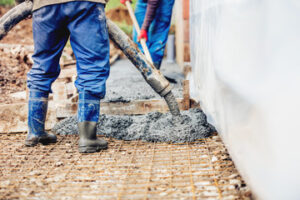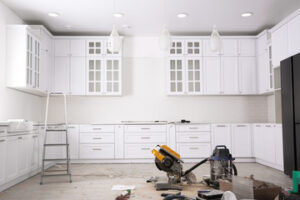Concrete Contractors McKinney TX construct concrete structures for both commercial and residential projects. They prepare the site by clearing debris and leveling ground surfaces, then install reinforcement materials like rebar to strengthen the final concrete structure.

They also mix and pour the concrete mixture according to project specifications. They pay special attention to finishing techniques, ensuring structural integrity and aesthetic appeal.
The concrete industry is constantly evolving as new technologies and materials enter the market. A reputable concrete contractor keeps abreast of these developments to provide better outcomes for contemporary building projects. Concrete contractors work closely with architects and engineers to transform architectural concepts into reality. They offer expert feedback on concrete specifications, construction techniques, and feasibility analyses to ensure the integrity of the final structure.
A solid track record of completing concrete projects on time and within budget is an excellent indicator of a contractor’s reliability and expertise. Ask potential contractors for a list of reference clients and review their portfolio to assess their quality of workmanship. Look for projects that are similar to your project scope, focusing on concrete types and finishes you are considering.
Inquire about the contractor’s experience handling unforeseen challenges that may arise during the project. Seek to understand how they handle these situations and if they have contingency plans in place to mitigate any impacts on the project’s timeline or budget. You can also ask about their process for managing change orders and how they communicate with clients throughout the project to ensure expectations are clearly aligned.
When choosing a concrete contractor, it is important to consider the contractor’s warranty policy. Choosing a contractor with a generous warranty indicates their confidence in the quality of their work and willingness to stand by it long after the project is complete. A comprehensive warranty will cover any repairs or replacements that might be necessary due to material defects, workmanship errors, or structural issues arising from improper installation or site conditions.
When evaluating potential contractors, make sure to request a copy of their license and insurance coverage. Verify that their license is valid for the type of concrete work you require and that it complies with local regulations. You can often find this information on the state licensing board website. Inquire about any additional certifications or affiliations with industry organizations that indicate a strong commitment to professionalism and adherence to professional standards. Lastly, it is vital to establish clear payment terms and schedules from the beginning of your relationship with a concrete contractor to avoid any surprises down the road.
License
Obtaining a license in the concrete construction industry can help contractors take on larger residential and commercial/government construction projects, which can increase earnings. It also demonstrates expertise and ensures compliance with state regulations. Additionally, licensed professionals can often get preferred access to government contracts, which typically have budgets in the six or seven-figure range. Licensed contractors are also more likely to have repeat clients, as they’re seen as more reliable.
Licensing requirements vary by state and region, but the process generally includes passing trade exams, submitting applications, and paying licensing fees. Some states may even require that contractors meet specific experience qualifications or pass a background check. It’s also important to familiarize yourself with local regulations, as some municipalities may have unique requirements for insurance and bonding.
Getting a concrete contractor license requires a mix of skills and knowledge, including understanding the latest concrete techniques and safety protocols. To prepare for the exam, enroll in a pre-licensing program that can provide you with the necessary resources to master the trade. Some programs even offer online prep tools that allow you to take practice tests in simulated real-world situations. The exam itself will cover topics like the trade, laws and rules, and business practices. To maximize your chances of passing, be sure to study extensively and use a variety of study materials.
The license is valid for three years and can be renewed annually. The requirements for renewal are similar to those of initial licensure, with the exception that the applicant must have at least four years of work experience. In addition, the contractor must have a current liability insurance policy in the amount of $50,000 per occurrence and $300,000 aggregate coverage for bodily injury and property damage.
The state of Florida’s unique climate and growing population make it an ideal place to start a concrete contractor business. This career offers stability and financial opportunity, as well as a pivotal role in shaping the Sunshine State’s infrastructure. To get started, learn about the state’s licensing requirements and the best practices for setting up a concrete contractor business.
Portfolio
Concrete contractors are specialized professionals who handle every aspect of concrete projects, from planning to installation and maintenance. They use their skills and expertise to create beautiful and functional structures that are both durable and aesthetically pleasing. The next time you walk on a sidewalk or drive on a road, take a moment to appreciate the hard work of these dedicated professionals.
When choosing a concrete contractor, it is important to check their portfolio and experience. Look for a diverse portfolio that showcases different project types and pays attention to details. In addition, ask about their ability to deliver results within the estimated timeline. This is a critical factor that can significantly affect the project’s overall success.
A commercial concrete contractor with extensive experience is likely to provide better quality service than a newer contractor. It is also a good idea to check their reputation and customer satisfaction rating. If possible, visit past projects to see the finished result and assess their workmanship quality.
It is also important to choose a contractor who can accommodate your budgetary constraints. A reputable contractor will be open to discussing your financial concerns and may have creative ideas on how to maximize quality without straining your budget. Moreover, they should be able to collaborate with architects and engineers to ensure a smooth construction process.
Inquire about a contractor’s commitment to sustainable practices. These include the use of eco-friendly materials and energy-efficient construction techniques. They should also be familiar with Leadership in Energy and Environmental Design (LEED) certification, which is an internationally recognized standard for environmentally conscious construction.
In addition to ensuring that the concrete contractor has the required credentials, you should also make sure that they are properly insured. This will protect you in the event that they cause damage to your property while working on your project. In addition, you should get a written contract detailing all of the project details and payment terms. This will prevent any confusion and disagreements down the road. Lastly, be sure to consider the contractor’s level of communication and customer support. A reputable contractor will be able to explain the details of your project clearly and respond quickly to any questions or concerns.
Reliability
Concrete contractors are specialized professionals who build strong, durable structures that stand the test of time. Their industry experience helps them navigate challenges and deliver projects on time. They also use the latest technology and construction techniques to ensure quality results. When looking for a contractor, consider their reputation, portfolio, and customer reviews. In addition to these traits, a reliable contractor will always follow building codes and regulations, which protects their clients from liability issues.
A reliable concrete contractor will have a strong attention to detail and take pride in their work. They will take the time to examine the project site and consider factors like soil conditions and load requirements. This meticulous approach ensures that the finished product will meet the client’s expectations.
In addition, a reliable concrete contractor will provide excellent customer service. They will be easy to communicate with, and they will make every effort to minimize disruption to the work site. They will also take the time to answer any questions and address any concerns.
When hiring a concrete contractor, be sure to ask about their previous projects and references. This will help you decide whether they are a good fit for your needs. Also, ask about their experience in the local area and check their licenses and insurance coverage. Choosing a reputable contractor will ensure that your project is completed on time and within budget.
Many homeowners hire contractors to perform a variety of tasks, from driveway installation to basement finishing. However, not all contractors have the same level of skill and professionalism. Choosing the right contractor can be challenging, but a little bit of research can make the process much easier.
The most dependable concrete contractors will have years of experience and a proven track record of completing projects on time and within budget. They will be knowledgeable about the latest materials and construction methods, and they will be able to recommend solutions that fit your specific needs. They will also have a strong understanding of the local building codes and regulations, which can save you time and money.

